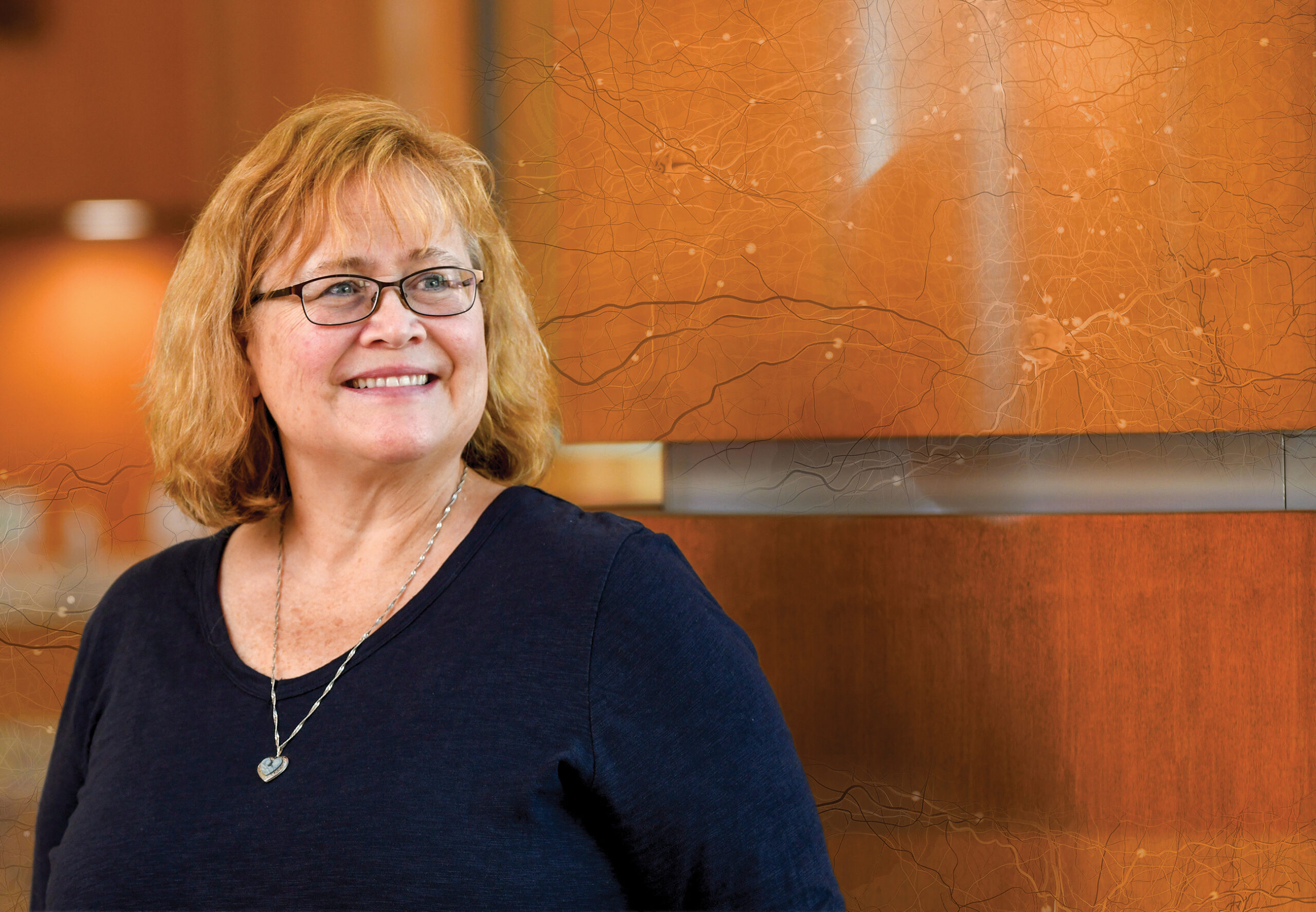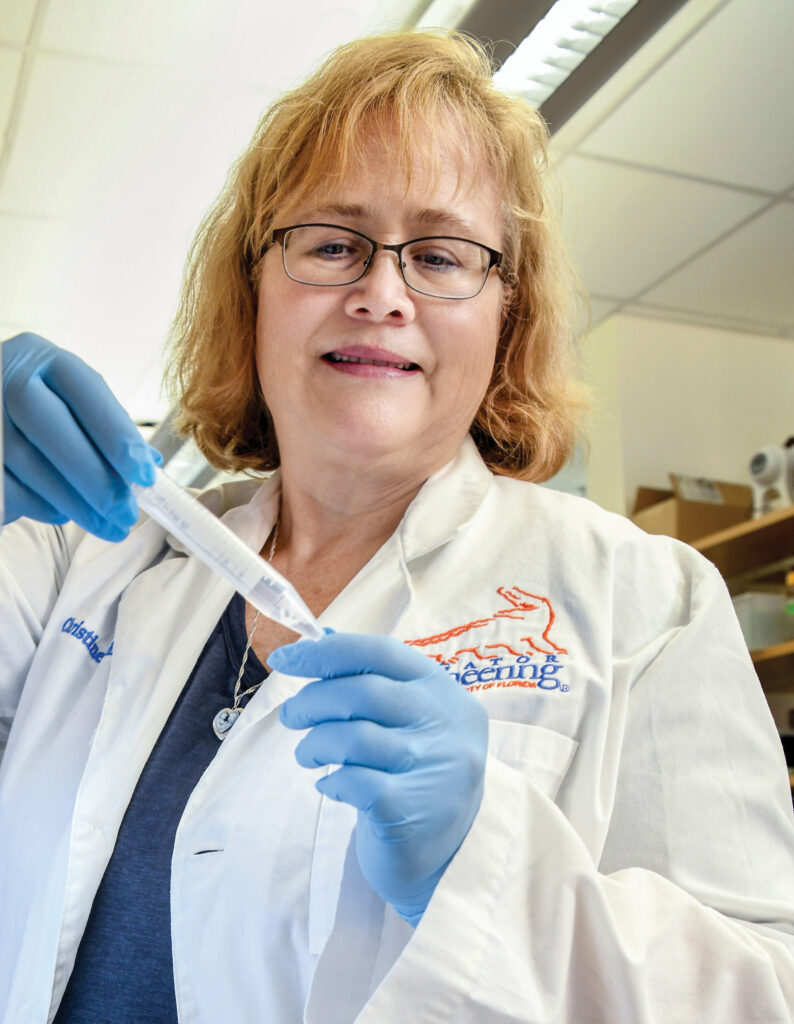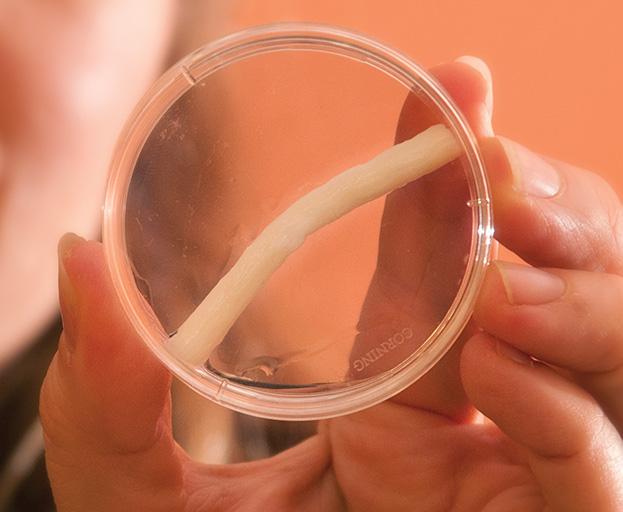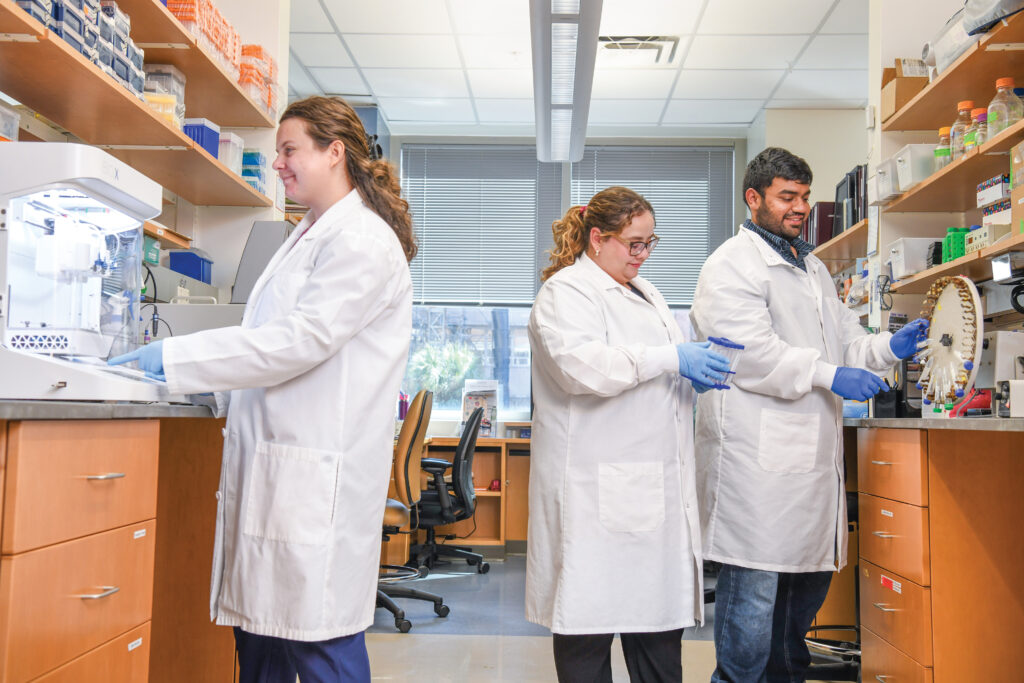U
niversity of Florida biomedical engineering Professor Christine Schmidt has spent nearly three decades developing ways to heal damaged nerves so that people like Shirley Pincus could live pain-free lives.
Pincus, who suffered from polio as a child, developed benign masses called neuromas on nerves in her left leg as an adult. For six years she searched for a treatment for pain she described as a 9 on a scale of 1-10.
Finally, she found a doctor in Chicago who suggested removing the neuromas and bridging the resulting gap with the Avance nerve graft, based on technology Schmidt developed at the University of Texas and licensed to Alachua County-based Axogen.
Pincus says she awoke from the surgery pain free and, after physical therapy, was able to resume her active lifestyle.
“You do not have to live with pain,” Pincus says. “Find the right doctor, get the right diagnosis and get the right treatment.”
It’s rare for Schmidt to actually meet a patient who has benefited from her discoveries, so when she and Pincus ended up on the same panel hosted by Axogen in 2016, emotions ran high on both sides.
“She spoke about her fears of amputation of her leg from the painful neuromas, her long quest to find a physician and surgeon who could help and finally learning about the nerve graft,” recalls Schmidt, UF’s J. Crayton Pruitt Family Endowed Chair in Biomedical Engineering.
“I spoke about my struggles getting funding and facing criticism for working on this research that was not as impactful in the academic world. After the panel, Shirley came up and gave me a hug and told me, ‘You are my hero.’ It was so emotional. I teared up.”
Nobody is questioning Schmidt’s impact these days. Last year, in the space of a few months, she was elected to the National Academy of Engineering and the National Academy of Medicine. For an academic to be chosen for either of these honors is a career milestone; to be elected to both is almost unprecedented.
As a biomedical engineer, Schmidt says she listens carefully to what doctors tell her about their needs, and in the area of neural regeneration, the doctors were telling her that the tools they had for repairing severed nerves were not sufficient.
In the early 2000s, there were two primary options available for nerve damage — synthetic grafts made from polymers or autologous grafts using a nerve from somewhere else in the patient’s body.
“The problem with the synthetic polymer grafts is that they were just hollow tubes. They did not promote nerve regeneration over longer distances, so a patient with a very large injury may have suffered amputation or other more dire consequences instead,” she said in an interview with Gainesville’s Cade Museum for Creativity and Invention in 2022.
Schmidt added that autologous grafts “require two surgeries, which is more risky to the patient and causes the patient to lose some function from somewhere else in the body.”
So Schmidt worked with her students at the University of Texas to create something that filled a niche between those
two options.
“We came up with this idea of taking donated nerve tissue and removing the cell components that caused immune response,” she said.
“We developed a nerve graft to function very similar to an autologous nerve graft, but instead of taking it from the patient themselves, we figured out a way to use donated cadaver tissue,” she said. “We used different types of chemicals and detergents to strip the cells out of nerve tissue and retain the intricate micro architecture of the nerve, which helped facilitate the axons of the nerves to regrow.”
The patient stories on the Axogen website are testament to the impact over 100,000 Avance grafts have had on people with a wide array of nerve injuries, like Jeffrey, who suffered severe damage to the ulnar nerve in his left arm when he was struck by gunfire while serving in Afghanistan; Jane, who lost sensation in her chest after a mastectomy; and Madie, a high school sophomore who lost feeling on one side of her tongue when a nerve was damaged during wisdom tooth surgery.
“It is truly humbling to see our laboratory research translate into meaningful advancements that have enhanced the lives of thousands of patients,” Schmidt says. “This type of impact means more to me than any publication or grant.”
Building on the success of the Avance graft, Schmidt’s team began looking at ways to apply similar approaches to other types of tissue.
It is truly humbling to see our laboratory research translate into meaningful advancements that have enhanced the lives of thousands of patients.”
— Christine Schmidt
“We had learned from Avance that structure is absolutely critical for any kind of healing tissue in general,” she said. “We were trying to understand how we could impart structure and micro architecture into other biomaterials so we could help guide cells and tissues to regenerate.”
One solution a student in her lab proposed was to use salt crystals to “lock in structural features within biomaterials.”
“When we wash out those crystals, they leave behind a template of pores and micro architecture that cells can follow and grow along for regeneration,” she said.
Schmidt’s lab originally intended to use the new process to make hydrogels for nerve regeneration, but while that didn’t work as well as intended, the materials had other useful properties, including the ability to slide across each other, like a lubricant.
“We found we could make thin films of these materials, almost like Saran Wrap, that could be used to promote healing after surgery,” she explained during her induction into the Florida Inventors Hall of Fame in 2021.
“After back surgery, for example, scars start to appear all over the place. It’s almost like weeds kind of growing in the body,” she said. “People have limited mobility because of that and a lot of pain, so surgeons will often have to go in and do multiple back surgeries.”
The result of this research is VersaWrap Hydrogel Sheet, which licensee Alafair Biosciences says has now been used in more than 25,000 patients to facilitate healing after surgery on tendons, ligaments, skeletal muscles and peripheral nerves.
“Alafair was founded to commercialize technology from Dr. Schmidt’s lab,” says Sarah Mayes, one of Schmidt’s former students at UT who is now chief scientific officer and co-founder of Alafair. “Christine is highly regarded as a revolutionary scientist among her peers. It is an honor to have graduated from her lab, and I am a better scientist because of her input. Christine is kind, brilliant, strong and cares not just deeply but thoughtfully. She is a great leader.”
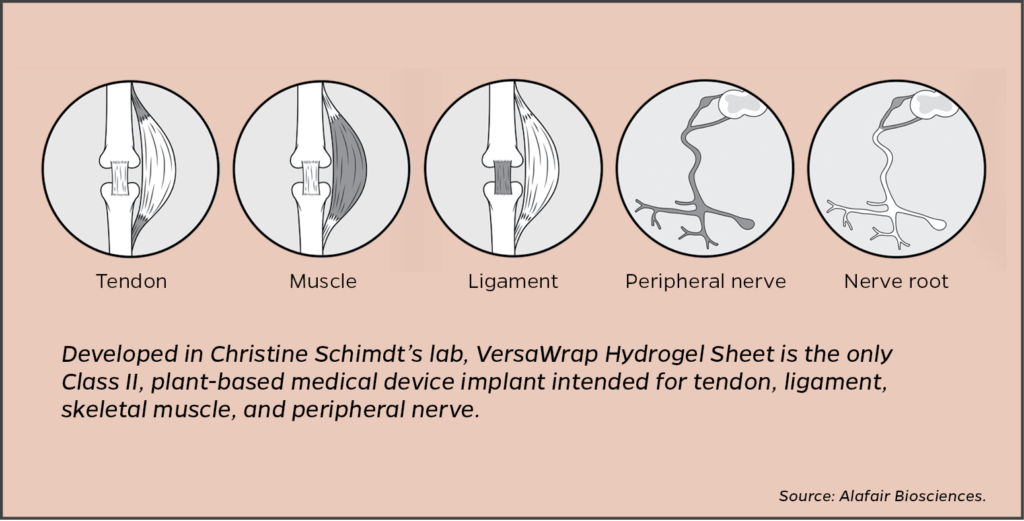
While all of these discoveries were being made, UF was working to grow its biomedical research capabilities in the Herbert Wertheim College of Engineering, so when the position of department chair opened up, Schmidt was an obvious choice.
“We needed someone who had a clear vision of what biomedical sciences can be, someone who has a real eye for talent, is a good mentor and a good recruiter. Someone who knew what excellence looks like,” says former College of Engineering Dean Cammy Abernathy. “When Christine came across our radar, she clearly stood out as someone who would be an outstanding addition.”
During her 10 years as chair, from 2013 to 2023, Schmidt recruited 24 faculty members to the department and tripled research expenditures per faculty member. In addition, the graduate program ranking rose significantly during this time.
“She really put us on the radar,” Abernathy says. “She did an excellent job recruiting a diverse faculty. We were successfully competing against some of the top programs in the country for talent, which is a testament to her reputation, her eye for talent and her ability to recruit and mentor.”
These days, Schmidt’s lab is working to provide doctors with solutions for patients suffering from spinal cord injury. Much of her recent research at the University of Florida has focused on developing injectable biomaterials that can inherently promote neural regeneration and which can also be used to deliver cells and therapeutics for spinal cord repair.
“Spinal cord injury affects 15 million people worldwide, with devastating impact on quality of life,” she says. “Our research is focused on analyzing and designing biomaterials that can interface with neurons and specifically stimulate and guide nerves to regenerate.”
In addition to providing a scaffold and pathway in which spinal nerves can regenerate, Schmidt’s team is using the hydrogel as a delivery vehicle for small molecules that can digest scar tissue and mitigate inflammatory cells at the site
of injury.
“We are exploring the delivery of Schwann cells, which are cells in healthy peripheral nerve tissue that can secrete pro-regenerative molecules,” she says. “We have shown in the lab that these materials can decrease inflammation that would normally inhibit repair after injury.”
Schmidt holds more than three dozen patents, which she says are a natural outgrowth of her basic research in biomedical engineering.
“We do our fundamental research in an academic setting … and along the way, we have the goal of hopefully being able to create innovations that could help people,” she says. “With biomedical engineering, the whole goal is to have an application that’s going to help human health. It’s part of my training, part of my education of our students, that we do the research and then we always look at what we can patent.”
This translational approach to research earned Schmidt the Biomedical Engineering Society’s 2024 Athanasiou Medal of Excellence in Translational Bioengineering. This honor recognizes contributions to biomedical engineering, with a focus on translating research into practical applications, particularly treating nerve damage.
“Dr. Schmidt’s novel approaches in developing biomaterials and regenerative therapies have set new standards in medical research and treatment,” says Forrest Masters, interim dean of the College of Engineering. “Her work not only exemplifies scientific excellence but also demonstrates a deep commitment to addressing critical health challenges.”
Source:
Christine Schmidt
Distinguished Professor and J. Crayton Pruitt Family Endowed Chair
J. Crayton Pruitt Family Department of Biomedical Engineering
schmidt@bme.ufl.edu

